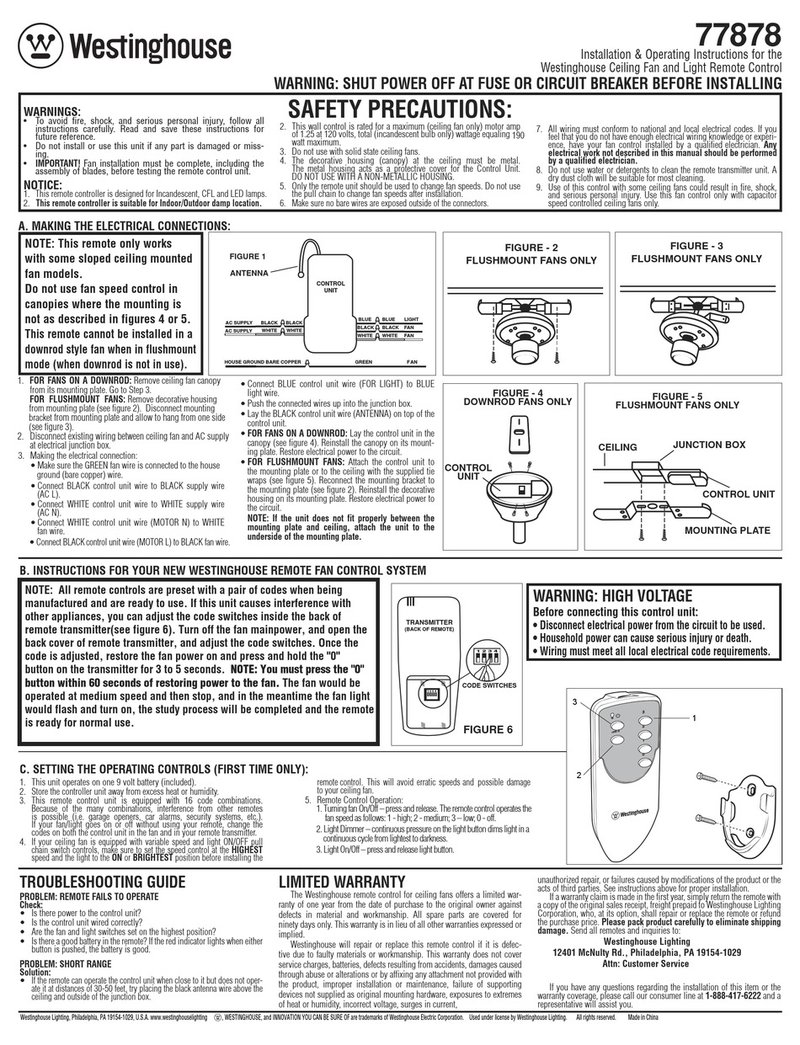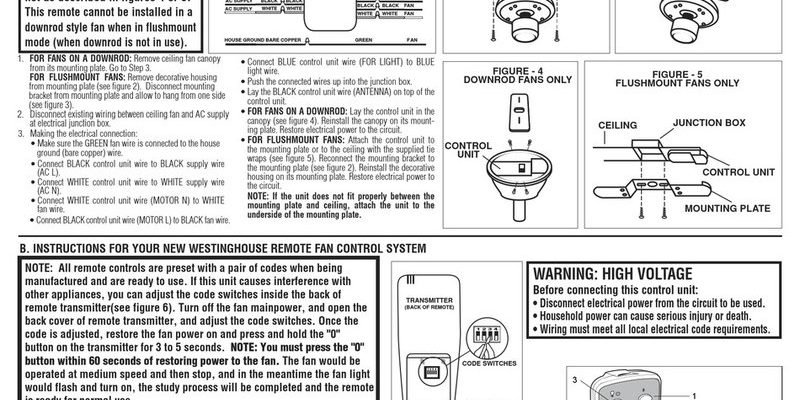
Think of a ceiling fan remote like a walkie-talkie for your ceiling fan. You expect it to work from your couch, sure—but what about from the kitchen, or the next room over? Understanding *exactly* how far you can wander before losing connection matters, especially if your living room is big or you’re hoping for a little “bed remote magic” from behind a closed door. Let me walk you through how these remotes work, what affects their range, and how you can make sure yours is sending signals smoothly.
How Do Westinghouse Ceiling Fan Remotes Work?
At the heart of every Westinghouse ceiling fan remote is a mix of *radio frequency* (RF) magic and some pretty basic electronics. Unlike the classic TV remote, which uses infrared (IR) and demands a direct line of sight, most Westinghouse ceiling fan remotes work on RF. What does that mean? You don’t have to aim directly at the fan. The remote sends a coded radio signal, and the receiver in the fan picks it up. It’s almost like old-school garage door openers, but on a smaller scale.
Here’s the thing: because it uses RF, you can often control your fan even if you aren’t in the same room—at least in theory. The remote’s signal *should* travel through walls or furniture. If you’ve got a fan or remote labeled “universal,” the story is nearly identical, but branded ones (like Westinghouse) are tuned specifically for their own receivers. That means fewer headaches over pairing and interference, at least when everything’s set up right.
The code, or “sync,” between the remote and the fan is set when you install the receiver in your fan’s canopy. Sometimes there are little dip switches or pairing steps that you have to match up. Get this wrong, and your remote might as well be a fancy paperweight. If everything is synced, your commands travel by invisible waves—no magic, just physics.
Typical Range of a Westinghouse Ceiling Fan Remote
So, how far will a Westinghouse ceiling fan remote really work? Westinghouse commonly *rates* their RF remotes for about 30 to 50 feet (roughly 10-15 meters). That’s the open-air, “best-case scenario” range, measured when nothing is blocking the way. Think of it like the “miles per gallon” on a car—it sounds great, but your actual performance may differ.
Honestly, in most homes, there are walls, doors, and all sorts of things that will absorb or bounce signals. On a typical day, you’re probably looking at closer to 20-30 feet, especially if you’re trying to use the remote from another room. Thick walls, brick, or even metal appliances in the way? That can push the range down further. And if your house is old with dense plaster or modern with a bunch of steel studs, you might notice the range drops off sharply.
It’s worth noting that batteries play a sneaky role here. Weak batteries mean a weaker signal, which cuts down the distance even more. Always check the battery first if your remote suddenly seems sluggish or inconsistent. I can’t tell you how many times I’ve watched someone disassemble their fan, only to realize a new battery would have fixed everything.
Factors That Affect Westinghouse Remote Range
Let me explain—real-life remote range comes down to more than just the manufacturer’s promise. It’s a messy mix of technology, architecture, and everyday stuff lying around your house. Here’s what matters most:
- Obstructions: Walls, ceilings, heavy furniture, and even large mirrors can soak up or deflect the radio signal. If the fan is on the other side of a couple of walls, expect the range to shrink.
- Interference: Other RF devices (like Wi-Fi routers, baby monitors, or cordless phones) can mess with your remote’s signal. Sometimes, a neighbor’s remote (if not properly coded) can even cause cross-talk.
- Remote and Receiver Placement: If the receiver in the fan is tucked deep inside a metal canopy or surrounded by wires, the signal might struggle to get through. Same goes if you’re holding the remote in a weird grip or have your hand over the antenna area.
- Battery Strength: As batteries run low, the signal gets weaker. You’ll notice the range drop bit by bit, sometimes long before the remote is completely dead.
If you’re wondering why your fan isn’t responding when you’re just across the room, it could be any one of these culprits. Sometimes, a simple fix—moving your Wi-Fi router, replacing a battery, or repositioning the fan’s receiver—can get you those extra few feet back.
How to Get the Best Range from Your Westinghouse Ceiling Fan Remote
Getting your remote to work reliably, even from across the room, isn’t just luck. Here are some practical steps you can take:
- Replace weak batteries. Fresh batteries boost your signal. Don’t wait until the remote is totally dead.
- Pair your remote and fan properly. Double-check the code or sync steps in the manual, especially if you’ve recently installed or reset the unit.
- Keep obstructions to a minimum. If you can, install your fan where there’s a clear path to your usual lounging spots. Avoid stuffing bulky items near the fan canopy or where the receiver sits.
- Avoid RF interference. If your home is filled with radio-based gadgets, try repositioning them or changing channels on things like cordless phones to reduce overlap.
- Troubleshoot before panicking. If you notice weaker range, swap batteries, move to a closer spot, or test with the door open. These little experiments can quickly reveal if you’re dealing with range issues or something more technical.
If you’re handy, you could even pop open the fan canopy and make sure the receiver antenna isn’t trapped or bent. Sometimes, simply letting the wire hang down a bit (without touching metal) can make a difference.
Troubleshooting: When Your Westinghouse Remote Stops Working Across the Room
You might be wondering what to do if your remote worked fine last week but now you have to stand right next to the fan for it to respond. Here are the main things to check:
- Dead or weak battery? Replace it, even if the tiny light on your remote still glows. Sometimes it’s just not strong enough for a full-range signal.
- Remote and receiver out of sync? Try resetting and re-pairing them by following the official pairing steps. Sometimes, after a power surge or battery swap, you need to re-sync the code.
- Physical blockages? Did you move a big bookshelf or hang a metal art piece near your fan recently? Even subtle changes in your space can block the radio signal.
- Interference or crossed signals? If a neighbor got the same fan (and didn’t change the code), their remote could interfere. In that case, change the dip switches or re-pair with a new code combination.
If you’ve tried all of these and your remote *still* won’t reach, it might be time to check the receiver itself. Sometimes, especially in humid climates, the receiver in the fan can degrade or lose connection. At that point, a replacement receiver (they’re not hard to swap) might be your answer.
Comparing Westinghouse Remotes to Universal and Other Brand Remotes
Honestly, Westinghouse remotes are built pretty standard compared to most ceiling fan remotes. The main thing that sets them apart is how *easy* they are to pair with matching Westinghouse receivers. Universal remotes try to cover more brands, but that can mean a little more code-juggling and a bigger chance of quirky connection problems.
Universal remotes sometimes claim up to 100 feet of range, but in the real world, you’re still fighting the same walls, interference, and battery issues. If you like things simple and reliable, sticking with the matching Westinghouse remote and receiver is usually less hassle. But, if you lose your branded remote or want just one remote for all your fans, a universal remote (with proper pairing) can still do the job—just don’t believe every “super long range” claim you read.
No matter which remote you use, remember: range is mostly about your space, your setup, and your batteries. Fancy features don’t change the laws of physics.
When to Reset, Replace, or Upgrade Your Remote Setup
If you’ve tried every trick and your remote won’t work past a certain distance, it’s time to consider a reset or even a new remote. Start by resetting the receiver and remote—Westinghouse manuals usually explain how, but it often involves turning off the power, pressing certain buttons, and letting the devices re-sync. If that doesn’t work, a new remote is usually inexpensive and straightforward to pair, especially if you stick with Westinghouse.
Upgrading to a *smart ceiling fan controller* (Wi-Fi based) is also an option if you crave longer range and phone control. These can often work from anywhere in the house—or even remotely via app. Just keep in mind, installation can be a bit more advanced, and like all things Wi-Fi, they come with their own quirks and troubleshooting.
Final Thoughts on Westinghouse Ceiling Fan Remote Range
So what’s the real answer to “How far will Westinghouse ceiling fan remote work?” In most homes, you’ll reliably control your fan from 20 to 30 feet away, even through a wall or two. The rated maximum is usually around 50 feet, but daily life—walls, furniture, interference, and low batteries—shrinks that a bit. Stick with strong batteries, pay attention to interference, and pair your remote properly for the best shot at a comfortable, couch-to-ceiling experience.
If you ever feel like your remote’s acting up, don’t panic. Start with the simple stuff, work your way through the troubleshooting steps, and remember—sometimes even the best gadgets need a little reset. Whether you’re working with a Westinghouse original or a universal model, knowing the limits and quirks of remote range means no more waving from the hallway, hoping for a breeze. Keep things simple, check your setup, and enjoy the comfort—right at your fingertips.
